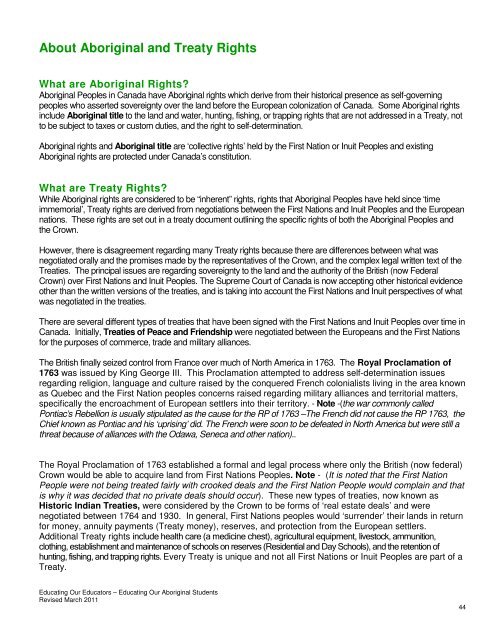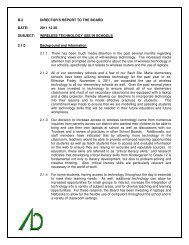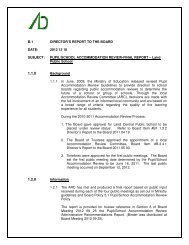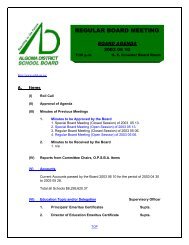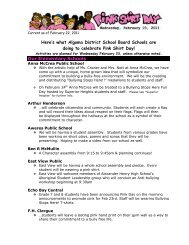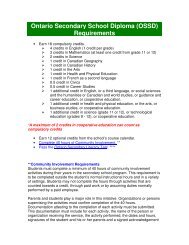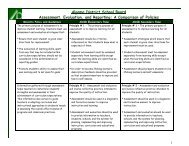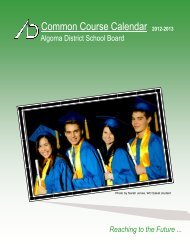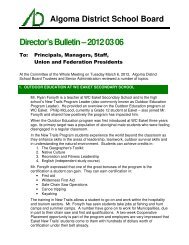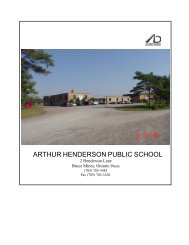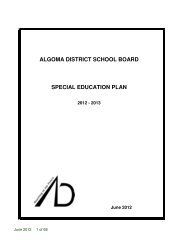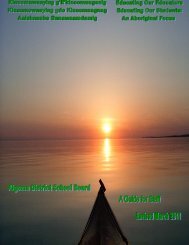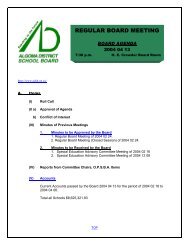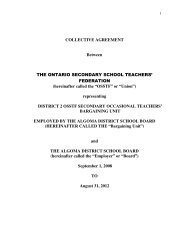Educating Our Educators Guide for Staff - Algoma District School ...
Educating Our Educators Guide for Staff - Algoma District School ...
Educating Our Educators Guide for Staff - Algoma District School ...
- No tags were found...
Create successful ePaper yourself
Turn your PDF publications into a flip-book with our unique Google optimized e-Paper software.
About Aboriginal and Treaty RightsWhat are Aboriginal Rights?Aboriginal Peoples in Canada have Aboriginal rights which derive from their historical presence as self-governingpeoples who asserted sovereignty over the land be<strong>for</strong>e the European colonization of Canada. Some Aboriginal rightsinclude Aboriginal title to the land and water, hunting, fishing, or trapping rights that are not addressed in a Treaty, notto be subject to taxes or custom duties, and the right to self-determination.Aboriginal rights and Aboriginal title are ‘collective rights’ held by the First Nation or Inuit Peoples and existingAboriginal rights are protected under Canada’s constitution.What are Treaty Rights?While Aboriginal rights are considered to be “inherent” rights, rights that Aboriginal Peoples have held since ‘timeimmemorial’, Treaty rights are derived from negotiations between the First Nations and Inuit Peoples and the Europeannations. These rights are set out in a treaty document outlining the specific rights of both the Aboriginal Peoples andthe Crown.However, there is disagreement regarding many Treaty rights because there are differences between what wasnegotiated orally and the promises made by the representatives of the Crown, and the complex legal written text of theTreaties. The principal issues are regarding sovereignty to the land and the authority of the British (now FederalCrown) over First Nations and Inuit Peoples. The Supreme Court of Canada is now accepting other historical evidenceother than the written versions of the treaties, and is taking into account the First Nations and Inuit perspectives of whatwas negotiated in the treaties.There are several different types of treaties that have been signed with the First Nations and Inuit Peoples over time inCanada. Initially, Treaties of Peace and Friendship were negotiated between the Europeans and the First Nations<strong>for</strong> the purposes of commerce, trade and military alliances.The British finally seized control from France over much of North America in 1763. The Royal Proclamation of1763 was issued by King George III. This Proclamation attempted to address self-determination issuesregarding religion, language and culture raised by the conquered French colonialists living in the area knownas Quebec and the First Nation peoples concerns raised regarding military alliances and territorial matters,specifically the encroachment of European settlers into their territory. - Note -(the war commonly calledPontiac’s Rebellion is usually stipulated as the cause <strong>for</strong> the RP of 1763 –The French did not cause the RP 1763, theChief known as Pontiac and his ‘uprising’ did. The French were soon to be defeated in North America but were still athreat because of alliances with the Odawa, Seneca and other nation)..The Royal Proclamation of 1763 established a <strong>for</strong>mal and legal process where only the British (now federal)Crown would be able to acquire land from First Nations Peoples. Note - (It is noted that the First NationPeople were not being treated fairly with crooked deals and the First Nation People would complain and thatis why it was decided that no private deals should occur). These new types of treaties, now known asHistoric Indian Treaties, were considered by the Crown to be <strong>for</strong>ms of ‘real estate deals’ and werenegotiated between 1764 and 1930. In general, First Nations peoples would ‘surrender’ their lands in return<strong>for</strong> money, annuity payments (Treaty money), reserves, and protection from the European settlers.Additional Treaty rights include health care (a medicine chest), agricultural equipment, livestock, ammunition,clothing, establishment and maintenance of schools on reserves (Residential and Day <strong>School</strong>s), and the retention ofhunting, fishing, and trapping rights. Every Treaty is unique and not all First Nations or Inuit Peoples are part of aTreaty.<strong>Educating</strong> <strong>Our</strong> <strong>Educators</strong> – <strong>Educating</strong> <strong>Our</strong> Aboriginal StudentsRevised March 201144


